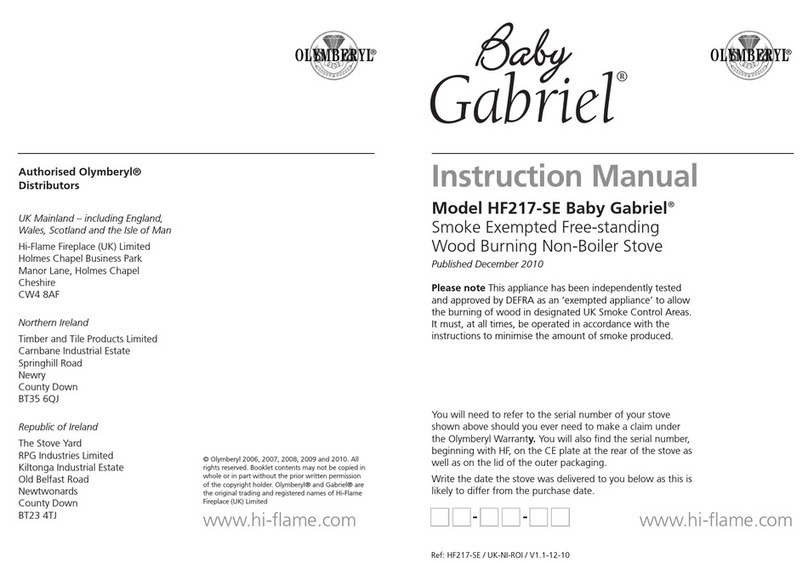
ASSEMBLING THE STOVE
Your new cast iron stove is extremely
heavy. Always handle it with care and
make sure that you have additional
strong help when you move it.
The ash lip on the Baby Gabriel® is
factory fitted and, along with the door
and door handle, should not be used
to grip the stove as they could be
damaged from supporting the stove’s
weight. Items, such as fuel retaining
bars, can be removed to help reduce
the weight. Under no circumstances
should the door be removed as this will
invalidate your Hi-Flame Warranty.
• Unpack Remove your new stove from
its recyclable packaging. Retain this
until the stove is installed and is fully
operational. Unfasten retaining wires
and remove any components, including
those inside the ash pan, from inside
the stove
• Inspect Please inspect the stove to
check that it has not been damaged in
transit – never attempt to install a stove
which has been damaged. If damage is
suspected then report this immediately
to your stove dealer
• Check List Study the component
packing list on page 4 and make sure
that you have all of the components
listed before proceeding. Some
components are contained within the
ash pan
• Legs Gently lay the stove on its back
to access the base. Use old carpet or
cushions to prevent damage to the back
of the stove. Remove the four bolts at
each corner of the base of the stove.
10
These are to protect the leg bolt hole
threads during the production process.
Use machine oil to lubricate the leg
bolts before fitting each of the legs. The
washer is fitted between the bolt head
and leg flange. Do not over-tighten
these bolts as this will damage the cast
iron.
Return the stove to the upright position
being careful to help ease the weight
and pressure on the rear legs. Do not
drag the stove once the legs have been
fitted. Always lift the stove to finally
position it. Alternatively it may be
possible to place the stove on heavy
duty plastic sheeting or thick floor
covering to slide the stove into
position, being careful not to damage
any finished floor surfaces with trapped
grit or building debris
• Baffle Plate Check the position of
the baffle plate (sometimes known as
the throat plate) inside the ‘roof’ of the
stove to ensure that it has not moved
during transit. This is a heavy metal
plate which directs flames and helps
retain heat inside the stove. The base of
this plate should sit securely on a small
ledge at the back of the firechamber,
towards the top. The rest of the plate is
supported by two additional retaining
lugs at the top middle of the side
firebricks to maintain it at the correct
angle and in line with the top of these
side firebricks. It is best to fully
familiarise yourself with the baffle
plate’s correct location by practising
removing it and re-fitting it prior to the
stove’s installation as you will need to
regularly check the top of this plate
and the access to the flueway to avoid




























